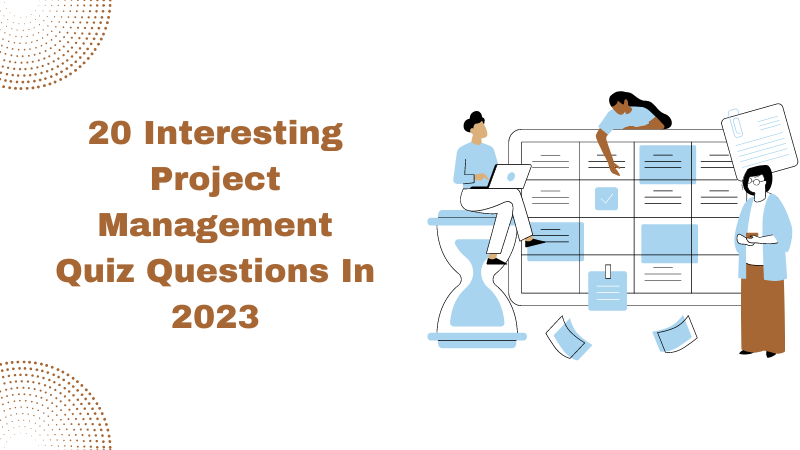Project management is a skill that is essential to any successful business. Failing to do it properly will doom your business before it even starts. This quiz is made for people that already have some good knowledge about project management. It will test your knowledge of project management and allow you to compare your knowledge with other people that have also taken the test. This Blog will provide you with 20 interesting project management quiz questions in 2023 to test your knowledge and to help you to stay up to date with the latest PMI® Project Management body of knowledge.
Now, let’s get started with some interesting project management quiz questions and their answers for students to improve their knowledge.
Q1. All of the following factors must be in place in order to develop an analogous estimate effectively EXCEPT:
a. An organization must know details behind the time value of money.
b. An organization must know how and to what extent the proposed project differs from the previous project.
c. An organization must have experience in performing similar projects.
d. An organization must know how much previous projects actually cost.
Q2. Complex projects such as research and development for new products often employ rolling wave planning to estimate costs. Which of the following best describes “rolling wave” planning?
a. Project managers render a definitive estimate for the first stage and an order of magnitude estimate for the remainder of the project.
b. Project managers render an order of magnitude estimate for the first stage and a definitive estimate for the remainder of the project.
c. Project managers render definitive estimates for all stages of the project during initiation.
d. Project managers render an order of magnitude estimate for all stages of the project.
Q3. A milestone is a typical measuring point used when establishing cost control. Which of the following does NOT accurately describes the use of cost control milestones?
a. Milestones are often identified in the project charter.
b. Project managers can use their cash flow projections to determine the funding needed to reach each milestone.
c. Milestones are developed during risk planning.
d. Project managers and sponsors often decide the number of milestones jointly.
Q4. Events discovered during Identify Risks that may or may not occur are often categorized as:
a. unknown unknowns
b. known certainties
c. known knowns
d. known unknowns
Q5. Activity based costing allocates overhead (indirect costs) to fixed costs based upon four different types of drivers. Which of the following is one of the cost drivers that serves as a basis of cost allocation?
a. quantity of materials used
b. direct equipment costs
c. number of units produced
d. number of labor hours
Q6. Which of the following terms best describes extra money in the project budget to be used if necessary – usually if a risk event occurs?
a. padding
b. discretionary fund
c. insurance
d. reserve
Q7. The documentation of a project cost estimate generally requires substantial supporting detail to include all of these EXCEPT:
a. management reserve needs
b. a description of scope
c. assumptions and constraints
d. the estimating methods and a range of possible outcomes
Q8. Projects often include indirect costs that are necessary to keep the organization running, but are not associated with one specific project. Which of the following items are most typically considered to be indirect costs?
a. travel cost for the project team
b. costs associated with material and purchased parts
c. the cost of labor provided by project team members, consultants and subcontractors
d. executive salaries, utilities and insurance
Q9. “Unknown unknowns” are unexpected events which can occur when the project is underway. All of the following accurately describe an implication associated with unknown unknowns EXCEPT:
a. They need to be covered in the project budget
b. They usually cause an increase in cost and / or schedule
c. They usually require the use of management reserve
d. They are usually discovered during risk identification
Q10. Which estimating technique uses a statistical relationship between historical data and other variables (e.g., square footage in construction, lines of code in software development) to calculate an estimate for scope, cost and duration?
a. parametric estimating
b. Monte Carlo estimating
c. analogous estimating
d. bottom-up estimating
Q11. Vendor bid analysis is used to determine whether the price being asked by the vendors appears to be reasonable.
a. True
b. False
Q12. Recurring costs tend to occur during project planning and closing while nonrecurring costs tend to occur during project execution.
a. True
b. False
Q13. On agile projects, project managers may use rolling wave planning to estimate costs.
a. True
b. False
Q14. Inflating the value of future revenue and cost streams to account for the time value of money enables better project decisions.
a. True
b. False
Q15. Cost estimating is linked very closely with scope, schedule and resource planning.
a. True
b. False
Q16. Project managers should not lie to themselves or others regarding project costs.
a. True
b. False
Q17. A contingency reserve is money assigned to the project and allocated for identified risks for which contingent responses are developed.
a. True
b. False
Q18. Estimate Cost is the process of developing an approximation of the monetary resources needed to complete project activities.
a. True
b. False
Q19. Both normal and special cause variation add to project cost and need to be considered by project managers.
a. True
b. False
Q20. Fixed costs remain the same regardless of the size or volume of work, while variable costs vary directly with volume of use.
a. True
b. False
Answers
- a
- a
- c
- d
- c
- d
- a
- d
- d
- a
- a
- b
- a
- b
- a
- a
- a
- a
- a
- a

